Nursing Leadership: Role, Styles and Challenges in Healthcare
VerifiedAdded on 2023/06/14
|14
|3254
|93
AI Summary
This report analyses the main role of nursing leader in the healthcare profession and how these roles are successful in bringing change in the quality of the cure plan while working in unison with different organisations and different group of professionals. The report highlights the importance of situational leadership styles in healthcare, the critical strengths of a public health leader, and the challenges of culturally competent nursing care.
Contribute Materials
Your contribution can guide someone’s learning journey. Share your
documents today.
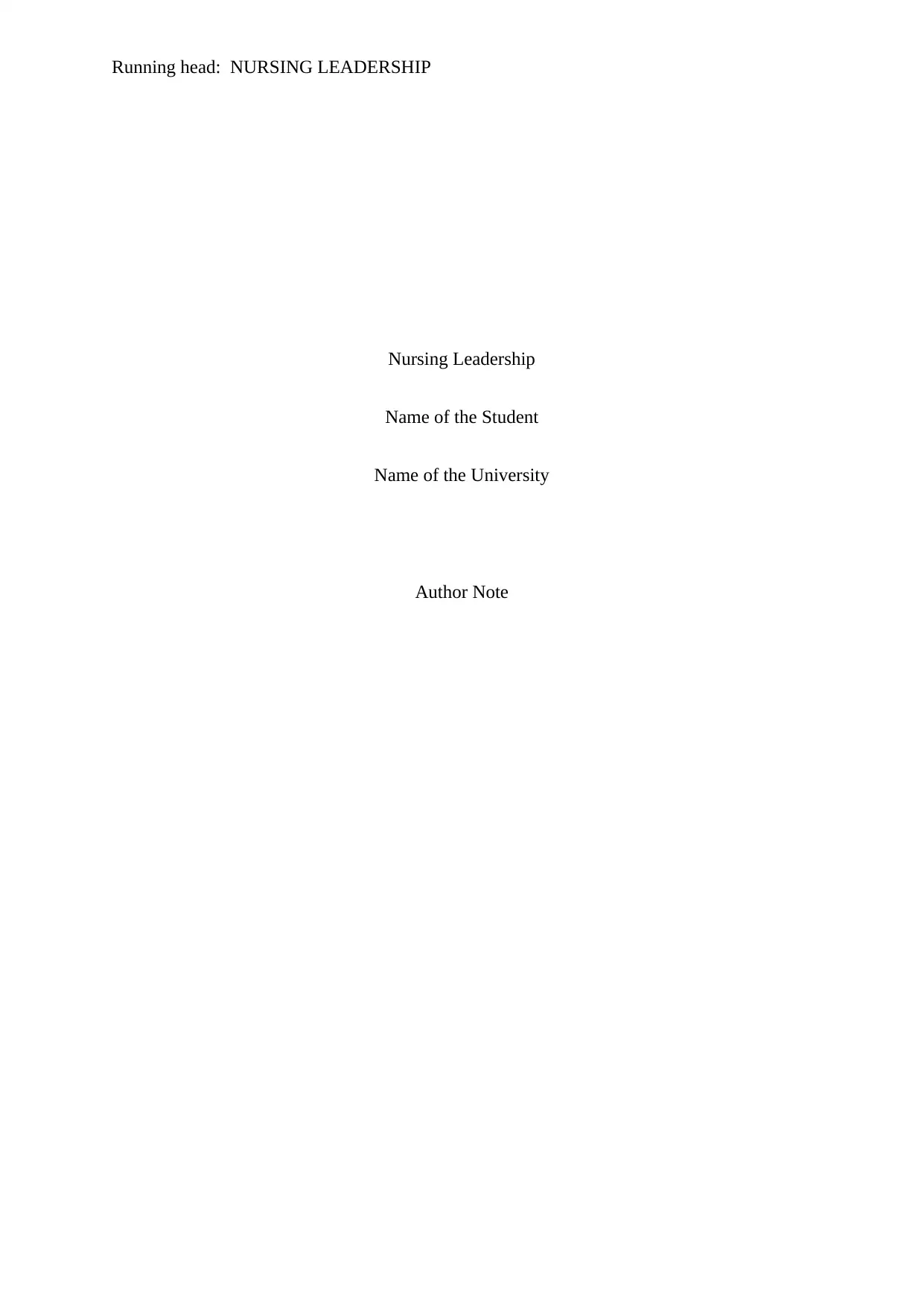
Running head: NURSING LEADERSHIP
Nursing Leadership
Name of the Student
Name of the University
Author Note
Nursing Leadership
Name of the Student
Name of the University
Author Note
Secure Best Marks with AI Grader
Need help grading? Try our AI Grader for instant feedback on your assignments.
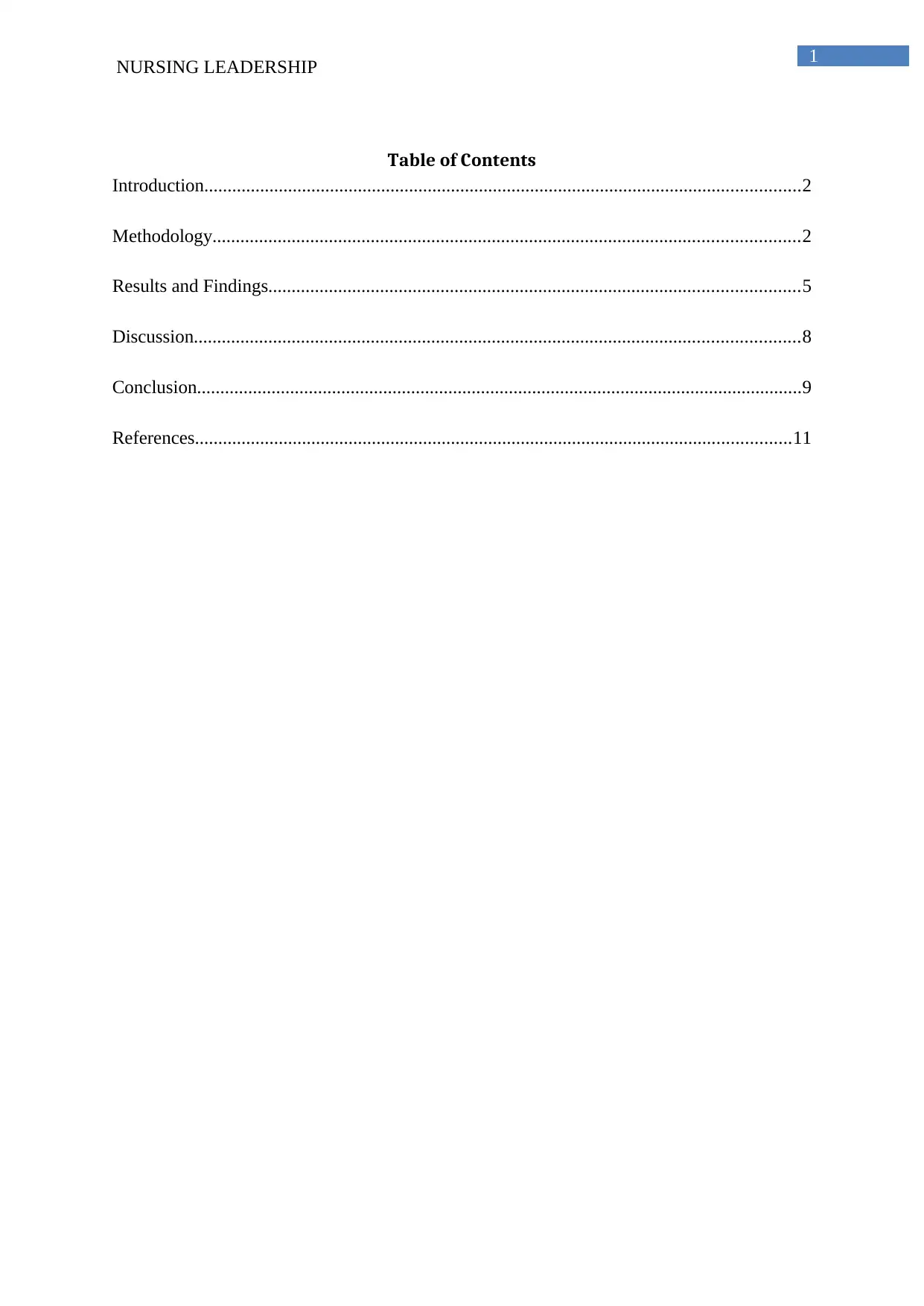
1
NURSING LEADERSHIP
Table of Contents
Introduction................................................................................................................................2
Methodology..............................................................................................................................2
Results and Findings..................................................................................................................5
Discussion..................................................................................................................................8
Conclusion..................................................................................................................................9
References................................................................................................................................11
NURSING LEADERSHIP
Table of Contents
Introduction................................................................................................................................2
Methodology..............................................................................................................................2
Results and Findings..................................................................................................................5
Discussion..................................................................................................................................8
Conclusion..................................................................................................................................9
References................................................................................................................................11
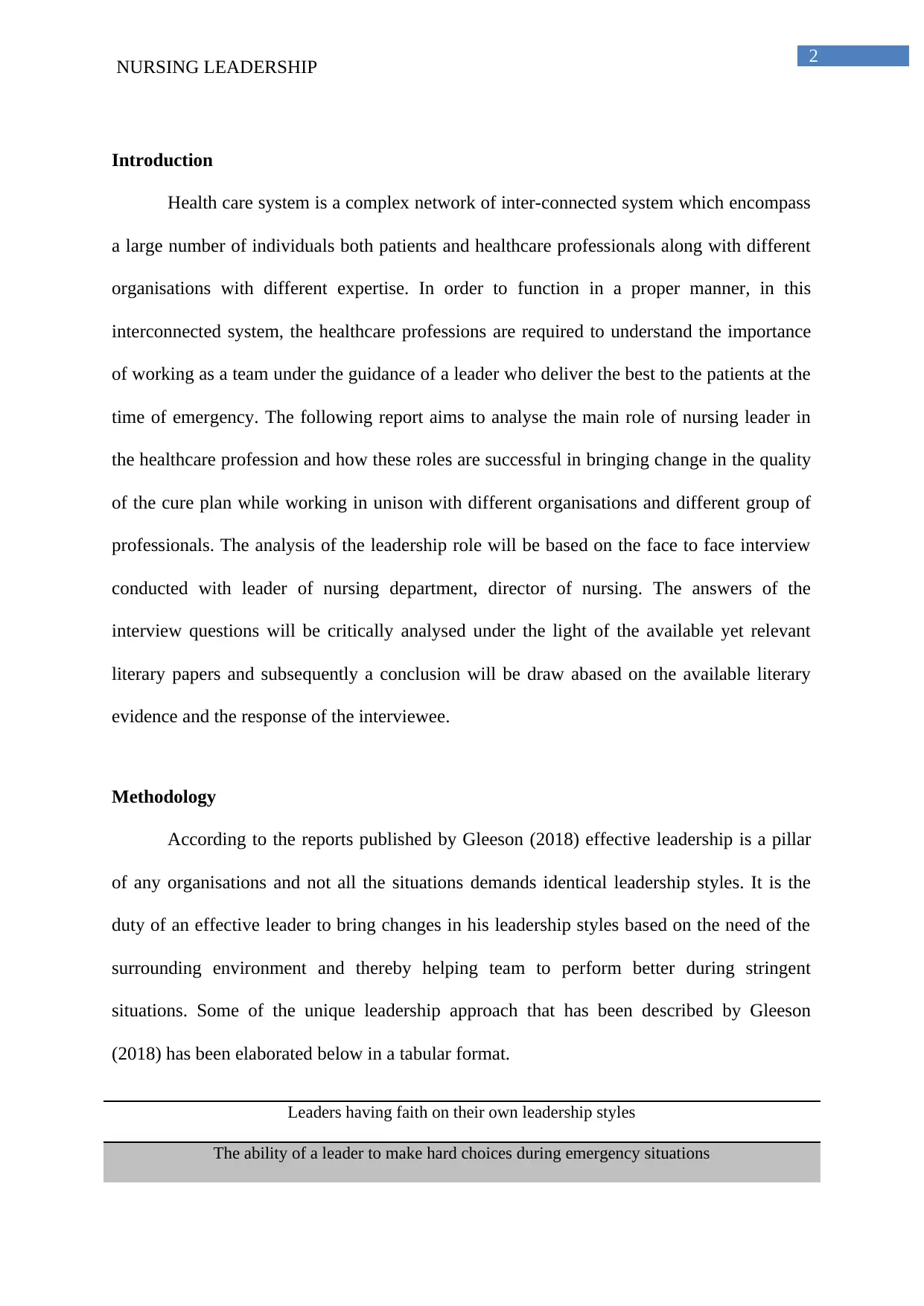
2
NURSING LEADERSHIP
Introduction
Health care system is a complex network of inter-connected system which encompass
a large number of individuals both patients and healthcare professionals along with different
organisations with different expertise. In order to function in a proper manner, in this
interconnected system, the healthcare professions are required to understand the importance
of working as a team under the guidance of a leader who deliver the best to the patients at the
time of emergency. The following report aims to analyse the main role of nursing leader in
the healthcare profession and how these roles are successful in bringing change in the quality
of the cure plan while working in unison with different organisations and different group of
professionals. The analysis of the leadership role will be based on the face to face interview
conducted with leader of nursing department, director of nursing. The answers of the
interview questions will be critically analysed under the light of the available yet relevant
literary papers and subsequently a conclusion will be draw abased on the available literary
evidence and the response of the interviewee.
Methodology
According to the reports published by Gleeson (2018) effective leadership is a pillar
of any organisations and not all the situations demands identical leadership styles. It is the
duty of an effective leader to bring changes in his leadership styles based on the need of the
surrounding environment and thereby helping team to perform better during stringent
situations. Some of the unique leadership approach that has been described by Gleeson
(2018) has been elaborated below in a tabular format.
Leaders having faith on their own leadership styles
The ability of a leader to make hard choices during emergency situations
NURSING LEADERSHIP
Introduction
Health care system is a complex network of inter-connected system which encompass
a large number of individuals both patients and healthcare professionals along with different
organisations with different expertise. In order to function in a proper manner, in this
interconnected system, the healthcare professions are required to understand the importance
of working as a team under the guidance of a leader who deliver the best to the patients at the
time of emergency. The following report aims to analyse the main role of nursing leader in
the healthcare profession and how these roles are successful in bringing change in the quality
of the cure plan while working in unison with different organisations and different group of
professionals. The analysis of the leadership role will be based on the face to face interview
conducted with leader of nursing department, director of nursing. The answers of the
interview questions will be critically analysed under the light of the available yet relevant
literary papers and subsequently a conclusion will be draw abased on the available literary
evidence and the response of the interviewee.
Methodology
According to the reports published by Gleeson (2018) effective leadership is a pillar
of any organisations and not all the situations demands identical leadership styles. It is the
duty of an effective leader to bring changes in his leadership styles based on the need of the
surrounding environment and thereby helping team to perform better during stringent
situations. Some of the unique leadership approach that has been described by Gleeson
(2018) has been elaborated below in a tabular format.
Leaders having faith on their own leadership styles
The ability of a leader to make hard choices during emergency situations
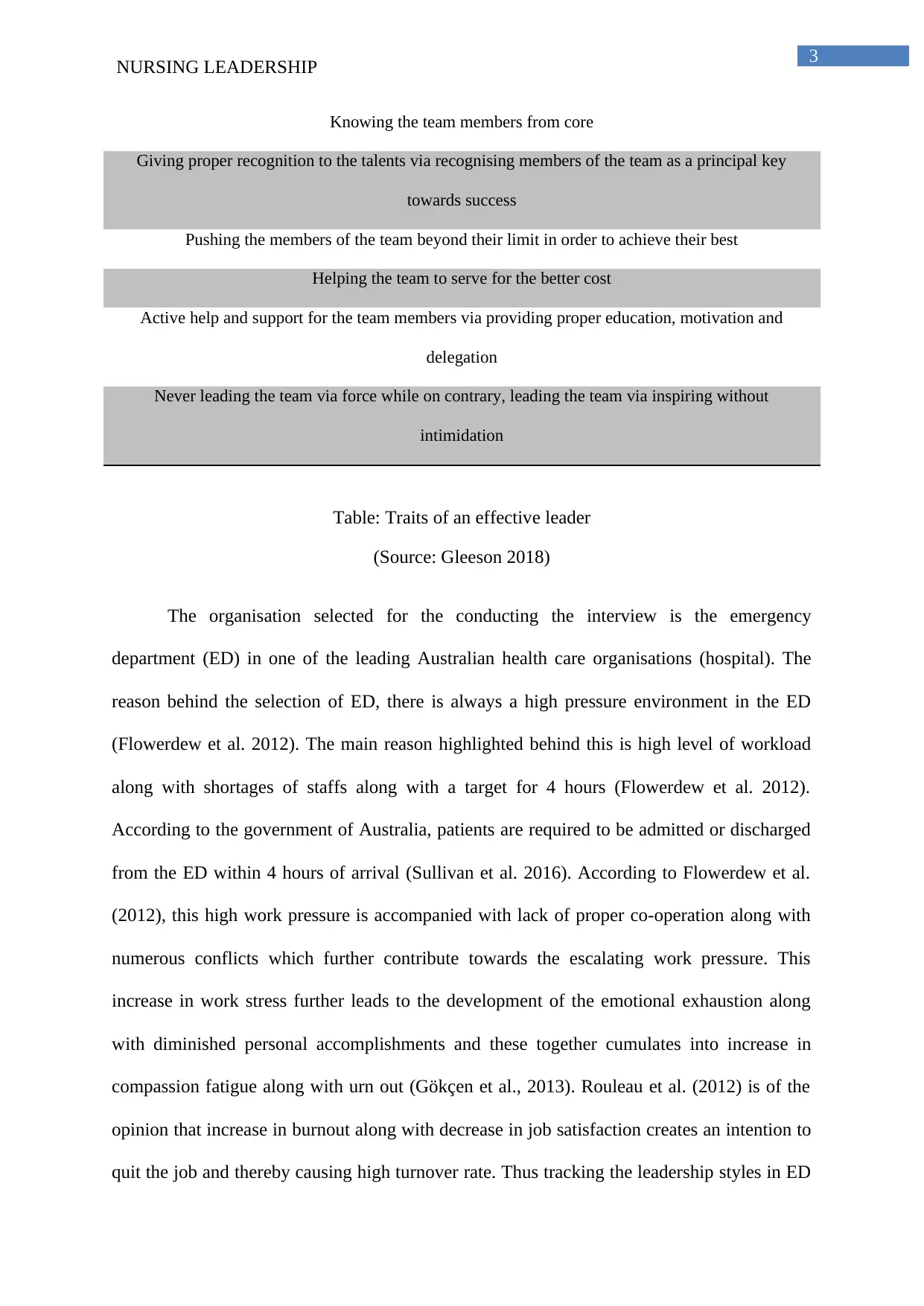
3
NURSING LEADERSHIP
Knowing the team members from core
Giving proper recognition to the talents via recognising members of the team as a principal key
towards success
Pushing the members of the team beyond their limit in order to achieve their best
Helping the team to serve for the better cost
Active help and support for the team members via providing proper education, motivation and
delegation
Never leading the team via force while on contrary, leading the team via inspiring without
intimidation
Table: Traits of an effective leader
(Source: Gleeson 2018)
The organisation selected for the conducting the interview is the emergency
department (ED) in one of the leading Australian health care organisations (hospital). The
reason behind the selection of ED, there is always a high pressure environment in the ED
(Flowerdew et al. 2012). The main reason highlighted behind this is high level of workload
along with shortages of staffs along with a target for 4 hours (Flowerdew et al. 2012).
According to the government of Australia, patients are required to be admitted or discharged
from the ED within 4 hours of arrival (Sullivan et al. 2016). According to Flowerdew et al.
(2012), this high work pressure is accompanied with lack of proper co-operation along with
numerous conflicts which further contribute towards the escalating work pressure. This
increase in work stress further leads to the development of the emotional exhaustion along
with diminished personal accomplishments and these together cumulates into increase in
compassion fatigue along with urn out (Gökçen et al., 2013). Rouleau et al. (2012) is of the
opinion that increase in burnout along with decrease in job satisfaction creates an intention to
quit the job and thereby causing high turnover rate. Thus tracking the leadership styles in ED
NURSING LEADERSHIP
Knowing the team members from core
Giving proper recognition to the talents via recognising members of the team as a principal key
towards success
Pushing the members of the team beyond their limit in order to achieve their best
Helping the team to serve for the better cost
Active help and support for the team members via providing proper education, motivation and
delegation
Never leading the team via force while on contrary, leading the team via inspiring without
intimidation
Table: Traits of an effective leader
(Source: Gleeson 2018)
The organisation selected for the conducting the interview is the emergency
department (ED) in one of the leading Australian health care organisations (hospital). The
reason behind the selection of ED, there is always a high pressure environment in the ED
(Flowerdew et al. 2012). The main reason highlighted behind this is high level of workload
along with shortages of staffs along with a target for 4 hours (Flowerdew et al. 2012).
According to the government of Australia, patients are required to be admitted or discharged
from the ED within 4 hours of arrival (Sullivan et al. 2016). According to Flowerdew et al.
(2012), this high work pressure is accompanied with lack of proper co-operation along with
numerous conflicts which further contribute towards the escalating work pressure. This
increase in work stress further leads to the development of the emotional exhaustion along
with diminished personal accomplishments and these together cumulates into increase in
compassion fatigue along with urn out (Gökçen et al., 2013). Rouleau et al. (2012) is of the
opinion that increase in burnout along with decrease in job satisfaction creates an intention to
quit the job and thereby causing high turnover rate. Thus tracking the leadership styles in ED
Secure Best Marks with AI Grader
Need help grading? Try our AI Grader for instant feedback on your assignments.
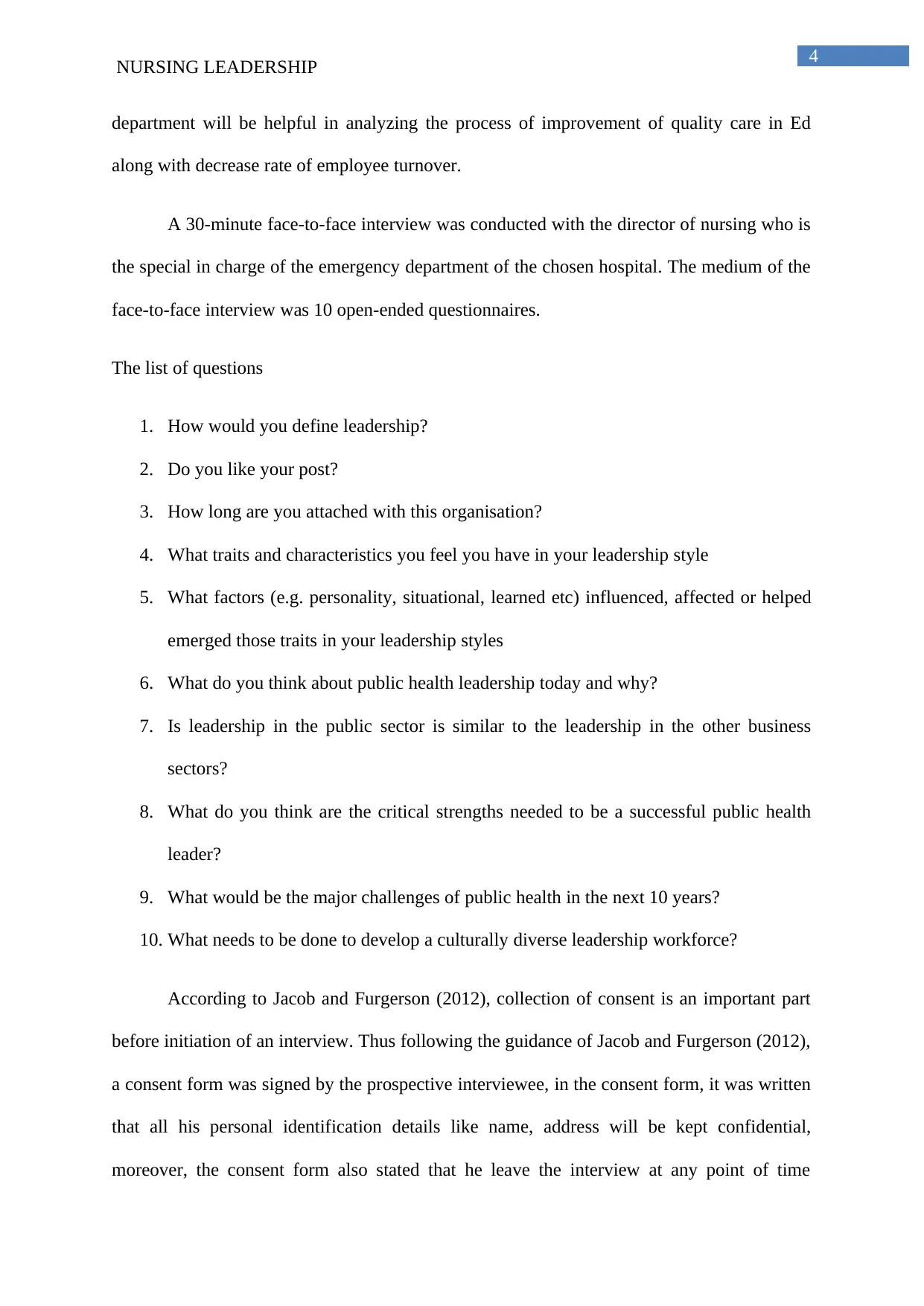
4
NURSING LEADERSHIP
department will be helpful in analyzing the process of improvement of quality care in Ed
along with decrease rate of employee turnover.
A 30-minute face-to-face interview was conducted with the director of nursing who is
the special in charge of the emergency department of the chosen hospital. The medium of the
face-to-face interview was 10 open-ended questionnaires.
The list of questions
1. How would you define leadership?
2. Do you like your post?
3. How long are you attached with this organisation?
4. What traits and characteristics you feel you have in your leadership style
5. What factors (e.g. personality, situational, learned etc) influenced, affected or helped
emerged those traits in your leadership styles
6. What do you think about public health leadership today and why?
7. Is leadership in the public sector is similar to the leadership in the other business
sectors?
8. What do you think are the critical strengths needed to be a successful public health
leader?
9. What would be the major challenges of public health in the next 10 years?
10. What needs to be done to develop a culturally diverse leadership workforce?
According to Jacob and Furgerson (2012), collection of consent is an important part
before initiation of an interview. Thus following the guidance of Jacob and Furgerson (2012),
a consent form was signed by the prospective interviewee, in the consent form, it was written
that all his personal identification details like name, address will be kept confidential,
moreover, the consent form also stated that he leave the interview at any point of time
NURSING LEADERSHIP
department will be helpful in analyzing the process of improvement of quality care in Ed
along with decrease rate of employee turnover.
A 30-minute face-to-face interview was conducted with the director of nursing who is
the special in charge of the emergency department of the chosen hospital. The medium of the
face-to-face interview was 10 open-ended questionnaires.
The list of questions
1. How would you define leadership?
2. Do you like your post?
3. How long are you attached with this organisation?
4. What traits and characteristics you feel you have in your leadership style
5. What factors (e.g. personality, situational, learned etc) influenced, affected or helped
emerged those traits in your leadership styles
6. What do you think about public health leadership today and why?
7. Is leadership in the public sector is similar to the leadership in the other business
sectors?
8. What do you think are the critical strengths needed to be a successful public health
leader?
9. What would be the major challenges of public health in the next 10 years?
10. What needs to be done to develop a culturally diverse leadership workforce?
According to Jacob and Furgerson (2012), collection of consent is an important part
before initiation of an interview. Thus following the guidance of Jacob and Furgerson (2012),
a consent form was signed by the prospective interviewee, in the consent form, it was written
that all his personal identification details like name, address will be kept confidential,
moreover, the consent form also stated that he leave the interview at any point of time
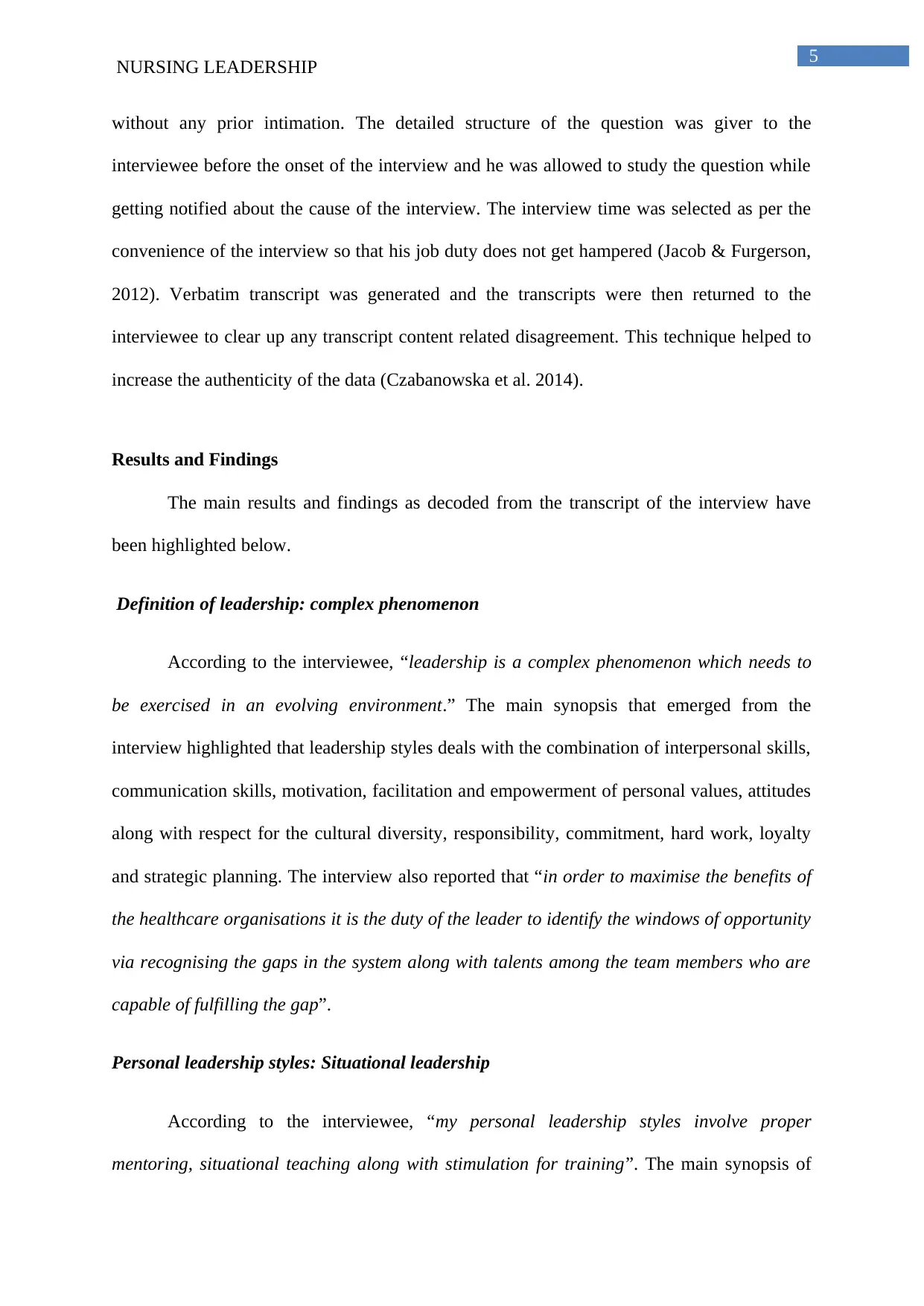
5
NURSING LEADERSHIP
without any prior intimation. The detailed structure of the question was giver to the
interviewee before the onset of the interview and he was allowed to study the question while
getting notified about the cause of the interview. The interview time was selected as per the
convenience of the interview so that his job duty does not get hampered (Jacob & Furgerson,
2012). Verbatim transcript was generated and the transcripts were then returned to the
interviewee to clear up any transcript content related disagreement. This technique helped to
increase the authenticity of the data (Czabanowska et al. 2014).
Results and Findings
The main results and findings as decoded from the transcript of the interview have
been highlighted below.
Definition of leadership: complex phenomenon
According to the interviewee, “leadership is a complex phenomenon which needs to
be exercised in an evolving environment.” The main synopsis that emerged from the
interview highlighted that leadership styles deals with the combination of interpersonal skills,
communication skills, motivation, facilitation and empowerment of personal values, attitudes
along with respect for the cultural diversity, responsibility, commitment, hard work, loyalty
and strategic planning. The interview also reported that “in order to maximise the benefits of
the healthcare organisations it is the duty of the leader to identify the windows of opportunity
via recognising the gaps in the system along with talents among the team members who are
capable of fulfilling the gap”.
Personal leadership styles: Situational leadership
According to the interviewee, “my personal leadership styles involve proper
mentoring, situational teaching along with stimulation for training”. The main synopsis of
NURSING LEADERSHIP
without any prior intimation. The detailed structure of the question was giver to the
interviewee before the onset of the interview and he was allowed to study the question while
getting notified about the cause of the interview. The interview time was selected as per the
convenience of the interview so that his job duty does not get hampered (Jacob & Furgerson,
2012). Verbatim transcript was generated and the transcripts were then returned to the
interviewee to clear up any transcript content related disagreement. This technique helped to
increase the authenticity of the data (Czabanowska et al. 2014).
Results and Findings
The main results and findings as decoded from the transcript of the interview have
been highlighted below.
Definition of leadership: complex phenomenon
According to the interviewee, “leadership is a complex phenomenon which needs to
be exercised in an evolving environment.” The main synopsis that emerged from the
interview highlighted that leadership styles deals with the combination of interpersonal skills,
communication skills, motivation, facilitation and empowerment of personal values, attitudes
along with respect for the cultural diversity, responsibility, commitment, hard work, loyalty
and strategic planning. The interview also reported that “in order to maximise the benefits of
the healthcare organisations it is the duty of the leader to identify the windows of opportunity
via recognising the gaps in the system along with talents among the team members who are
capable of fulfilling the gap”.
Personal leadership styles: Situational leadership
According to the interviewee, “my personal leadership styles involve proper
mentoring, situational teaching along with stimulation for training”. The main synopsis of
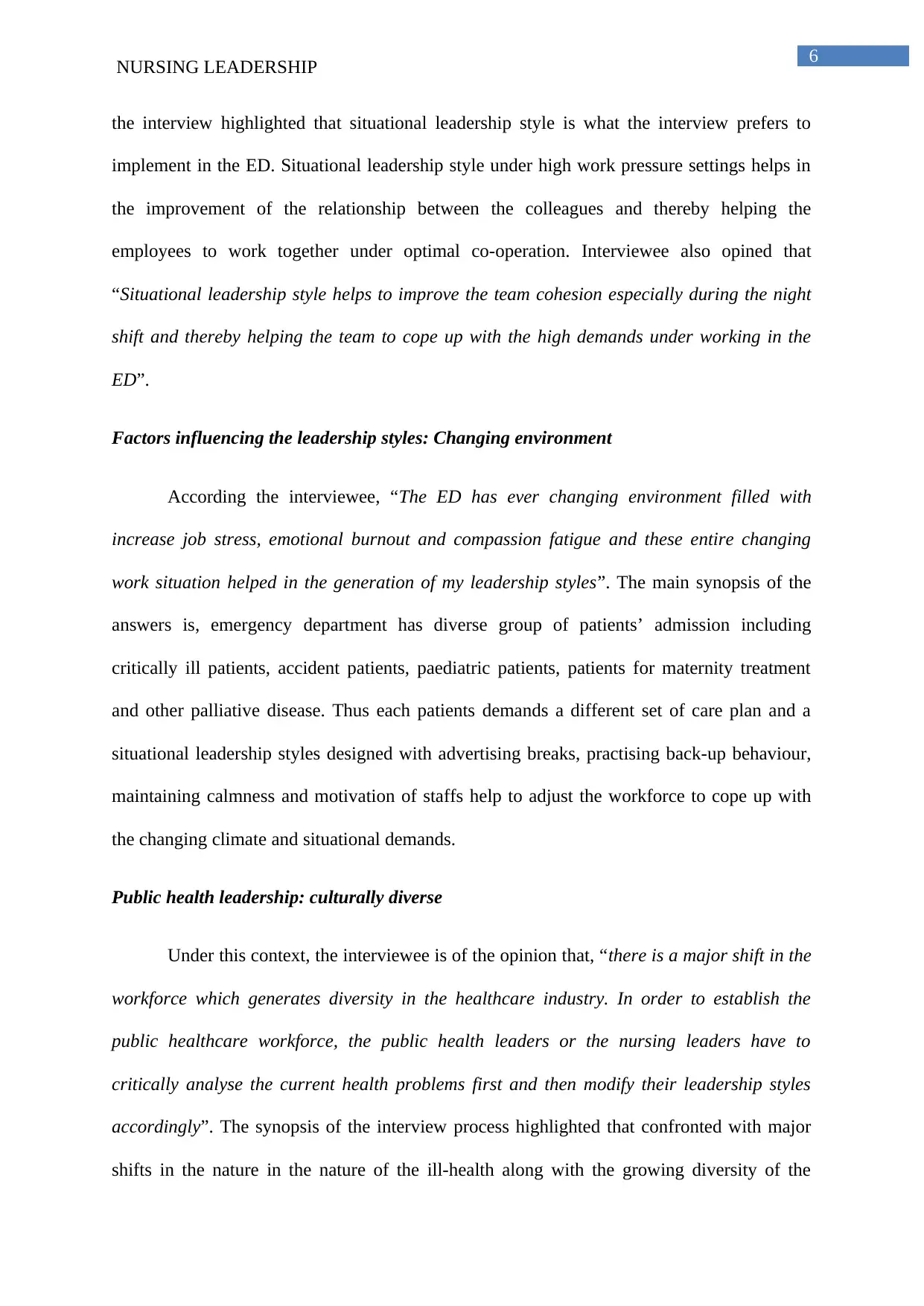
6
NURSING LEADERSHIP
the interview highlighted that situational leadership style is what the interview prefers to
implement in the ED. Situational leadership style under high work pressure settings helps in
the improvement of the relationship between the colleagues and thereby helping the
employees to work together under optimal co-operation. Interviewee also opined that
“Situational leadership style helps to improve the team cohesion especially during the night
shift and thereby helping the team to cope up with the high demands under working in the
ED”.
Factors influencing the leadership styles: Changing environment
According the interviewee, “The ED has ever changing environment filled with
increase job stress, emotional burnout and compassion fatigue and these entire changing
work situation helped in the generation of my leadership styles”. The main synopsis of the
answers is, emergency department has diverse group of patients’ admission including
critically ill patients, accident patients, paediatric patients, patients for maternity treatment
and other palliative disease. Thus each patients demands a different set of care plan and a
situational leadership styles designed with advertising breaks, practising back-up behaviour,
maintaining calmness and motivation of staffs help to adjust the workforce to cope up with
the changing climate and situational demands.
Public health leadership: culturally diverse
Under this context, the interviewee is of the opinion that, “there is a major shift in the
workforce which generates diversity in the healthcare industry. In order to establish the
public healthcare workforce, the public health leaders or the nursing leaders have to
critically analyse the current health problems first and then modify their leadership styles
accordingly”. The synopsis of the interview process highlighted that confronted with major
shifts in the nature in the nature of the ill-health along with the growing diversity of the
NURSING LEADERSHIP
the interview highlighted that situational leadership style is what the interview prefers to
implement in the ED. Situational leadership style under high work pressure settings helps in
the improvement of the relationship between the colleagues and thereby helping the
employees to work together under optimal co-operation. Interviewee also opined that
“Situational leadership style helps to improve the team cohesion especially during the night
shift and thereby helping the team to cope up with the high demands under working in the
ED”.
Factors influencing the leadership styles: Changing environment
According the interviewee, “The ED has ever changing environment filled with
increase job stress, emotional burnout and compassion fatigue and these entire changing
work situation helped in the generation of my leadership styles”. The main synopsis of the
answers is, emergency department has diverse group of patients’ admission including
critically ill patients, accident patients, paediatric patients, patients for maternity treatment
and other palliative disease. Thus each patients demands a different set of care plan and a
situational leadership styles designed with advertising breaks, practising back-up behaviour,
maintaining calmness and motivation of staffs help to adjust the workforce to cope up with
the changing climate and situational demands.
Public health leadership: culturally diverse
Under this context, the interviewee is of the opinion that, “there is a major shift in the
workforce which generates diversity in the healthcare industry. In order to establish the
public healthcare workforce, the public health leaders or the nursing leaders have to
critically analyse the current health problems first and then modify their leadership styles
accordingly”. The synopsis of the interview process highlighted that confronted with major
shifts in the nature in the nature of the ill-health along with the growing diversity of the
Paraphrase This Document
Need a fresh take? Get an instant paraphrase of this document with our AI Paraphraser
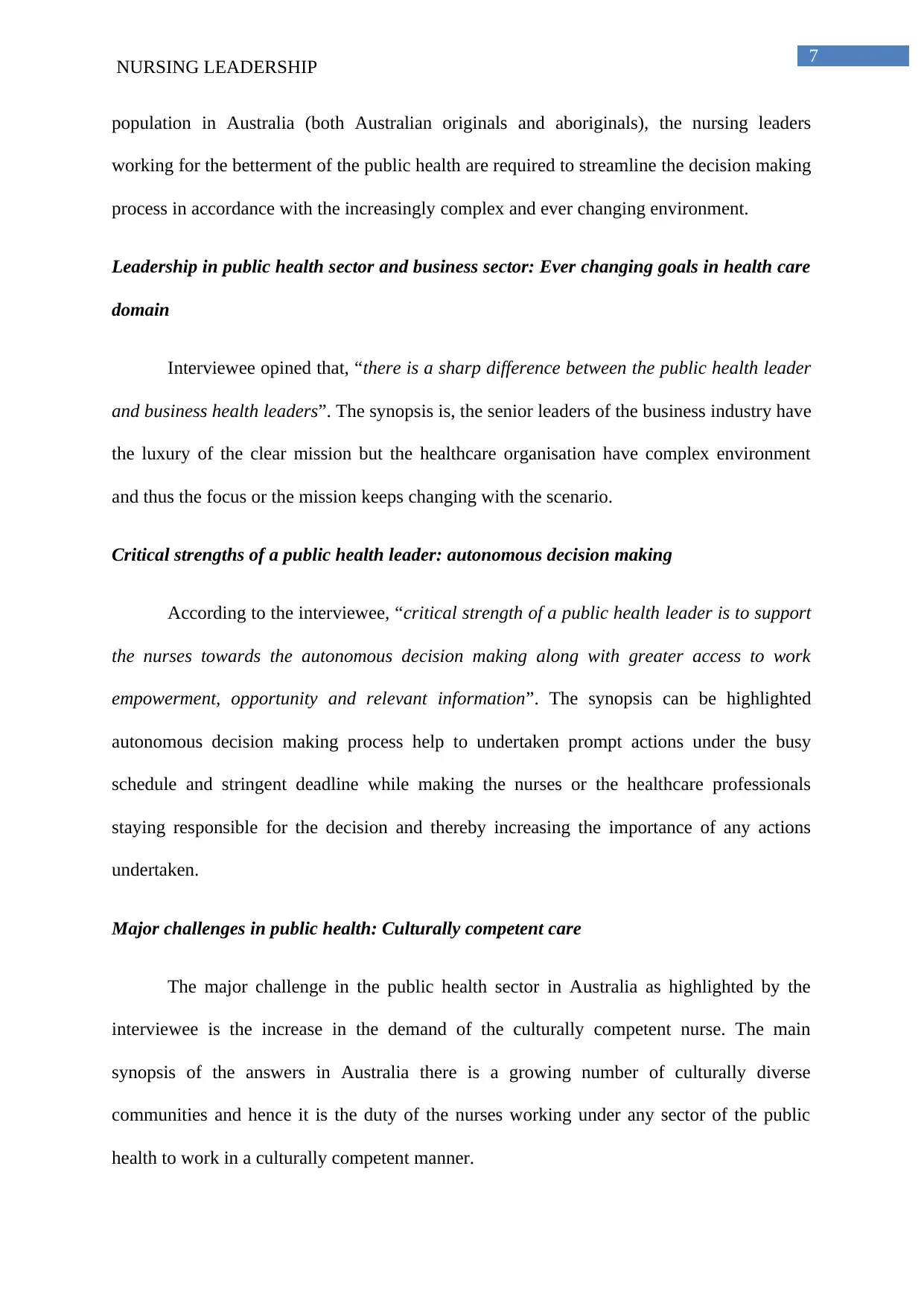
7
NURSING LEADERSHIP
population in Australia (both Australian originals and aboriginals), the nursing leaders
working for the betterment of the public health are required to streamline the decision making
process in accordance with the increasingly complex and ever changing environment.
Leadership in public health sector and business sector: Ever changing goals in health care
domain
Interviewee opined that, “there is a sharp difference between the public health leader
and business health leaders”. The synopsis is, the senior leaders of the business industry have
the luxury of the clear mission but the healthcare organisation have complex environment
and thus the focus or the mission keeps changing with the scenario.
Critical strengths of a public health leader: autonomous decision making
According to the interviewee, “critical strength of a public health leader is to support
the nurses towards the autonomous decision making along with greater access to work
empowerment, opportunity and relevant information”. The synopsis can be highlighted
autonomous decision making process help to undertaken prompt actions under the busy
schedule and stringent deadline while making the nurses or the healthcare professionals
staying responsible for the decision and thereby increasing the importance of any actions
undertaken.
Major challenges in public health: Culturally competent care
The major challenge in the public health sector in Australia as highlighted by the
interviewee is the increase in the demand of the culturally competent nurse. The main
synopsis of the answers in Australia there is a growing number of culturally diverse
communities and hence it is the duty of the nurses working under any sector of the public
health to work in a culturally competent manner.
NURSING LEADERSHIP
population in Australia (both Australian originals and aboriginals), the nursing leaders
working for the betterment of the public health are required to streamline the decision making
process in accordance with the increasingly complex and ever changing environment.
Leadership in public health sector and business sector: Ever changing goals in health care
domain
Interviewee opined that, “there is a sharp difference between the public health leader
and business health leaders”. The synopsis is, the senior leaders of the business industry have
the luxury of the clear mission but the healthcare organisation have complex environment
and thus the focus or the mission keeps changing with the scenario.
Critical strengths of a public health leader: autonomous decision making
According to the interviewee, “critical strength of a public health leader is to support
the nurses towards the autonomous decision making along with greater access to work
empowerment, opportunity and relevant information”. The synopsis can be highlighted
autonomous decision making process help to undertaken prompt actions under the busy
schedule and stringent deadline while making the nurses or the healthcare professionals
staying responsible for the decision and thereby increasing the importance of any actions
undertaken.
Major challenges in public health: Culturally competent care
The major challenge in the public health sector in Australia as highlighted by the
interviewee is the increase in the demand of the culturally competent nurse. The main
synopsis of the answers in Australia there is a growing number of culturally diverse
communities and hence it is the duty of the nurses working under any sector of the public
health to work in a culturally competent manner.
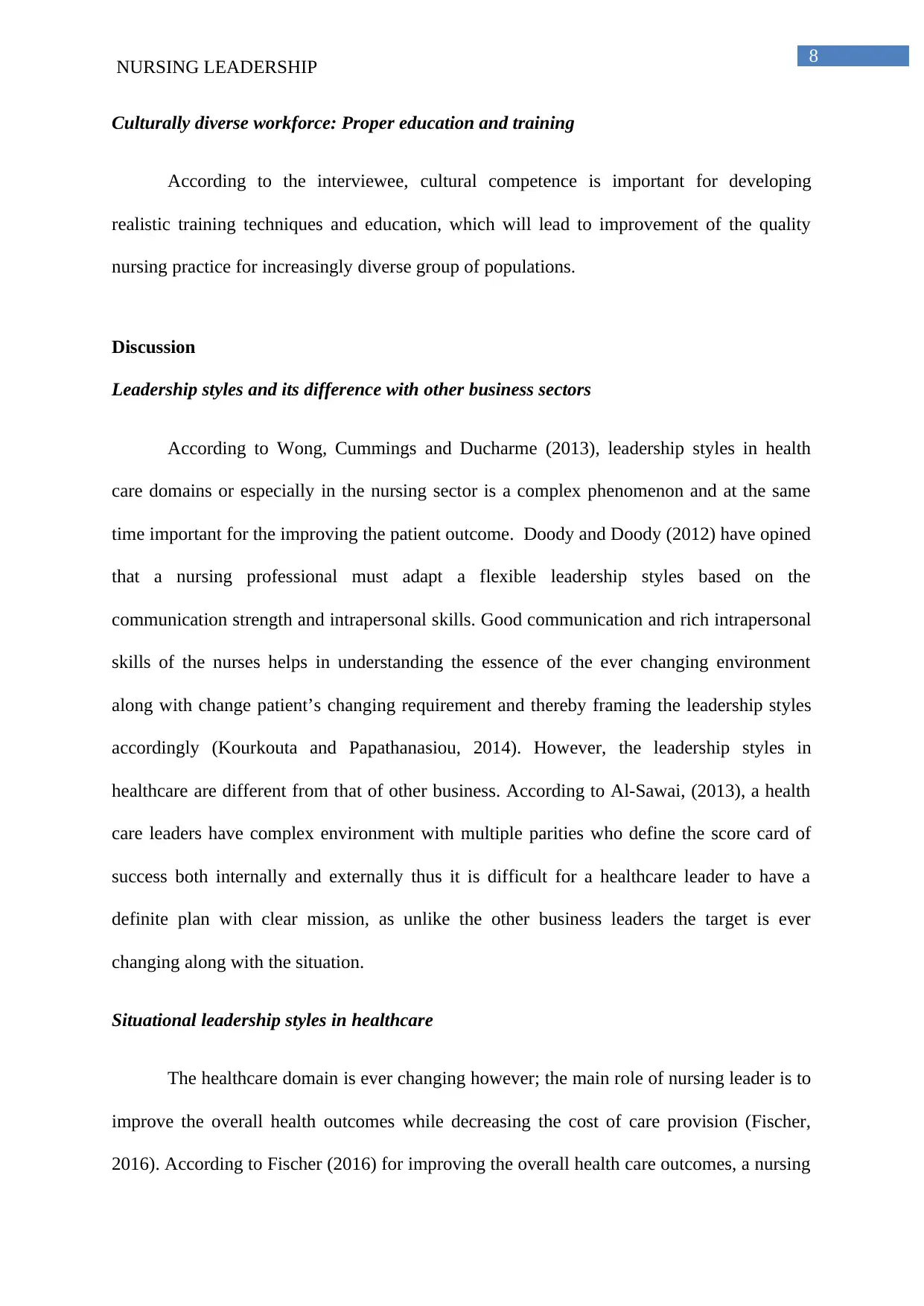
8
NURSING LEADERSHIP
Culturally diverse workforce: Proper education and training
According to the interviewee, cultural competence is important for developing
realistic training techniques and education, which will lead to improvement of the quality
nursing practice for increasingly diverse group of populations.
Discussion
Leadership styles and its difference with other business sectors
According to Wong, Cummings and Ducharme (2013), leadership styles in health
care domains or especially in the nursing sector is a complex phenomenon and at the same
time important for the improving the patient outcome. Doody and Doody (2012) have opined
that a nursing professional must adapt a flexible leadership styles based on the
communication strength and intrapersonal skills. Good communication and rich intrapersonal
skills of the nurses helps in understanding the essence of the ever changing environment
along with change patient’s changing requirement and thereby framing the leadership styles
accordingly (Kourkouta and Papathanasiou, 2014). However, the leadership styles in
healthcare are different from that of other business. According to Al-Sawai, (2013), a health
care leaders have complex environment with multiple parities who define the score card of
success both internally and externally thus it is difficult for a healthcare leader to have a
definite plan with clear mission, as unlike the other business leaders the target is ever
changing along with the situation.
Situational leadership styles in healthcare
The healthcare domain is ever changing however; the main role of nursing leader is to
improve the overall health outcomes while decreasing the cost of care provision (Fischer,
2016). According to Fischer (2016) for improving the overall health care outcomes, a nursing
NURSING LEADERSHIP
Culturally diverse workforce: Proper education and training
According to the interviewee, cultural competence is important for developing
realistic training techniques and education, which will lead to improvement of the quality
nursing practice for increasingly diverse group of populations.
Discussion
Leadership styles and its difference with other business sectors
According to Wong, Cummings and Ducharme (2013), leadership styles in health
care domains or especially in the nursing sector is a complex phenomenon and at the same
time important for the improving the patient outcome. Doody and Doody (2012) have opined
that a nursing professional must adapt a flexible leadership styles based on the
communication strength and intrapersonal skills. Good communication and rich intrapersonal
skills of the nurses helps in understanding the essence of the ever changing environment
along with change patient’s changing requirement and thereby framing the leadership styles
accordingly (Kourkouta and Papathanasiou, 2014). However, the leadership styles in
healthcare are different from that of other business. According to Al-Sawai, (2013), a health
care leaders have complex environment with multiple parities who define the score card of
success both internally and externally thus it is difficult for a healthcare leader to have a
definite plan with clear mission, as unlike the other business leaders the target is ever
changing along with the situation.
Situational leadership styles in healthcare
The healthcare domain is ever changing however; the main role of nursing leader is to
improve the overall health outcomes while decreasing the cost of care provision (Fischer,
2016). According to Fischer (2016) for improving the overall health care outcomes, a nursing
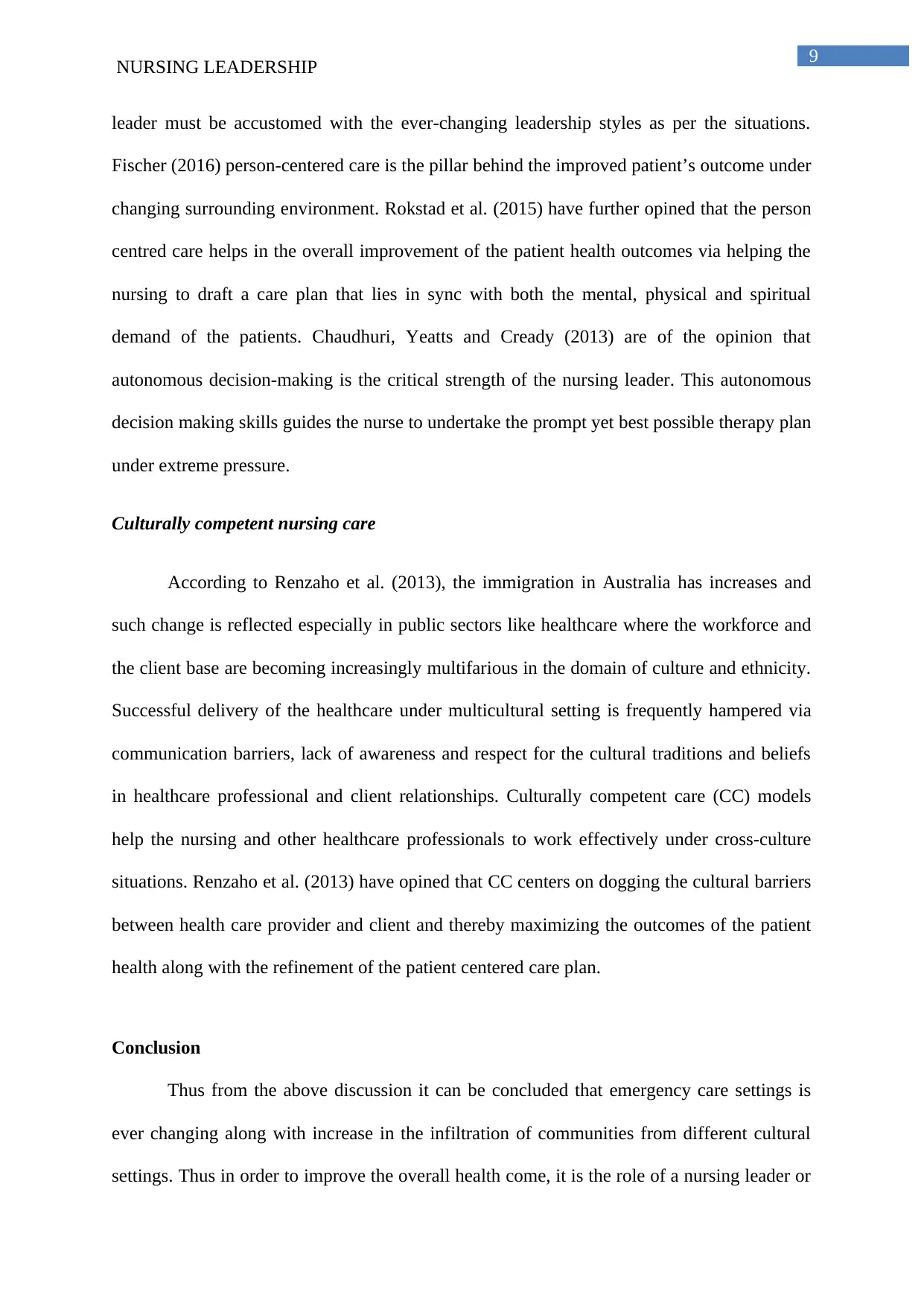
9
NURSING LEADERSHIP
leader must be accustomed with the ever-changing leadership styles as per the situations.
Fischer (2016) person-centered care is the pillar behind the improved patient’s outcome under
changing surrounding environment. Rokstad et al. (2015) have further opined that the person
centred care helps in the overall improvement of the patient health outcomes via helping the
nursing to draft a care plan that lies in sync with both the mental, physical and spiritual
demand of the patients. Chaudhuri, Yeatts and Cready (2013) are of the opinion that
autonomous decision-making is the critical strength of the nursing leader. This autonomous
decision making skills guides the nurse to undertake the prompt yet best possible therapy plan
under extreme pressure.
Culturally competent nursing care
According to Renzaho et al. (2013), the immigration in Australia has increases and
such change is reflected especially in public sectors like healthcare where the workforce and
the client base are becoming increasingly multifarious in the domain of culture and ethnicity.
Successful delivery of the healthcare under multicultural setting is frequently hampered via
communication barriers, lack of awareness and respect for the cultural traditions and beliefs
in healthcare professional and client relationships. Culturally competent care (CC) models
help the nursing and other healthcare professionals to work effectively under cross-culture
situations. Renzaho et al. (2013) have opined that CC centers on dogging the cultural barriers
between health care provider and client and thereby maximizing the outcomes of the patient
health along with the refinement of the patient centered care plan.
Conclusion
Thus from the above discussion it can be concluded that emergency care settings is
ever changing along with increase in the infiltration of communities from different cultural
settings. Thus in order to improve the overall health come, it is the role of a nursing leader or
NURSING LEADERSHIP
leader must be accustomed with the ever-changing leadership styles as per the situations.
Fischer (2016) person-centered care is the pillar behind the improved patient’s outcome under
changing surrounding environment. Rokstad et al. (2015) have further opined that the person
centred care helps in the overall improvement of the patient health outcomes via helping the
nursing to draft a care plan that lies in sync with both the mental, physical and spiritual
demand of the patients. Chaudhuri, Yeatts and Cready (2013) are of the opinion that
autonomous decision-making is the critical strength of the nursing leader. This autonomous
decision making skills guides the nurse to undertake the prompt yet best possible therapy plan
under extreme pressure.
Culturally competent nursing care
According to Renzaho et al. (2013), the immigration in Australia has increases and
such change is reflected especially in public sectors like healthcare where the workforce and
the client base are becoming increasingly multifarious in the domain of culture and ethnicity.
Successful delivery of the healthcare under multicultural setting is frequently hampered via
communication barriers, lack of awareness and respect for the cultural traditions and beliefs
in healthcare professional and client relationships. Culturally competent care (CC) models
help the nursing and other healthcare professionals to work effectively under cross-culture
situations. Renzaho et al. (2013) have opined that CC centers on dogging the cultural barriers
between health care provider and client and thereby maximizing the outcomes of the patient
health along with the refinement of the patient centered care plan.
Conclusion
Thus from the above discussion it can be concluded that emergency care settings is
ever changing along with increase in the infiltration of communities from different cultural
settings. Thus in order to improve the overall health come, it is the role of a nursing leader or
Secure Best Marks with AI Grader
Need help grading? Try our AI Grader for instant feedback on your assignments.
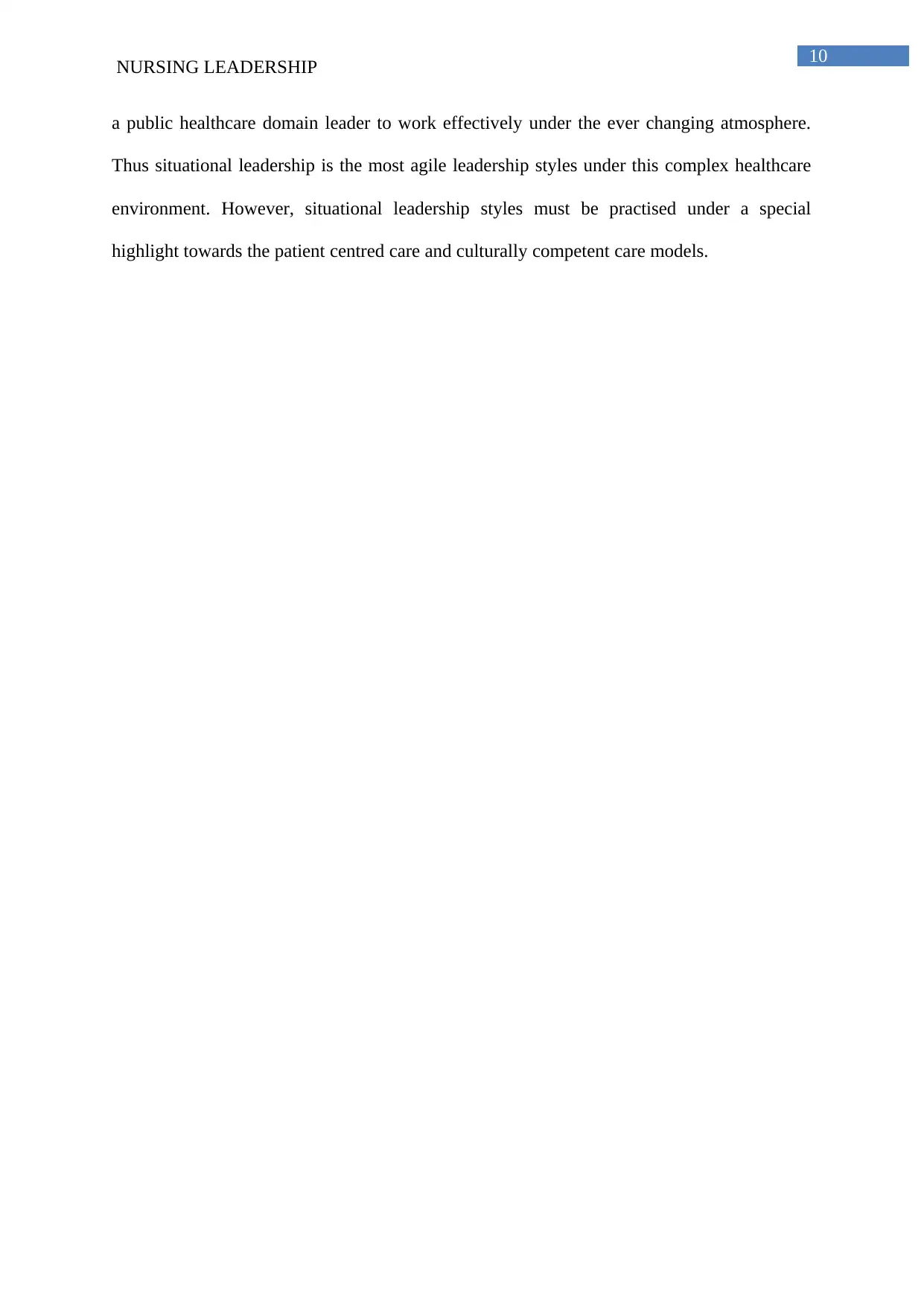
10
NURSING LEADERSHIP
a public healthcare domain leader to work effectively under the ever changing atmosphere.
Thus situational leadership is the most agile leadership styles under this complex healthcare
environment. However, situational leadership styles must be practised under a special
highlight towards the patient centred care and culturally competent care models.
NURSING LEADERSHIP
a public healthcare domain leader to work effectively under the ever changing atmosphere.
Thus situational leadership is the most agile leadership styles under this complex healthcare
environment. However, situational leadership styles must be practised under a special
highlight towards the patient centred care and culturally competent care models.
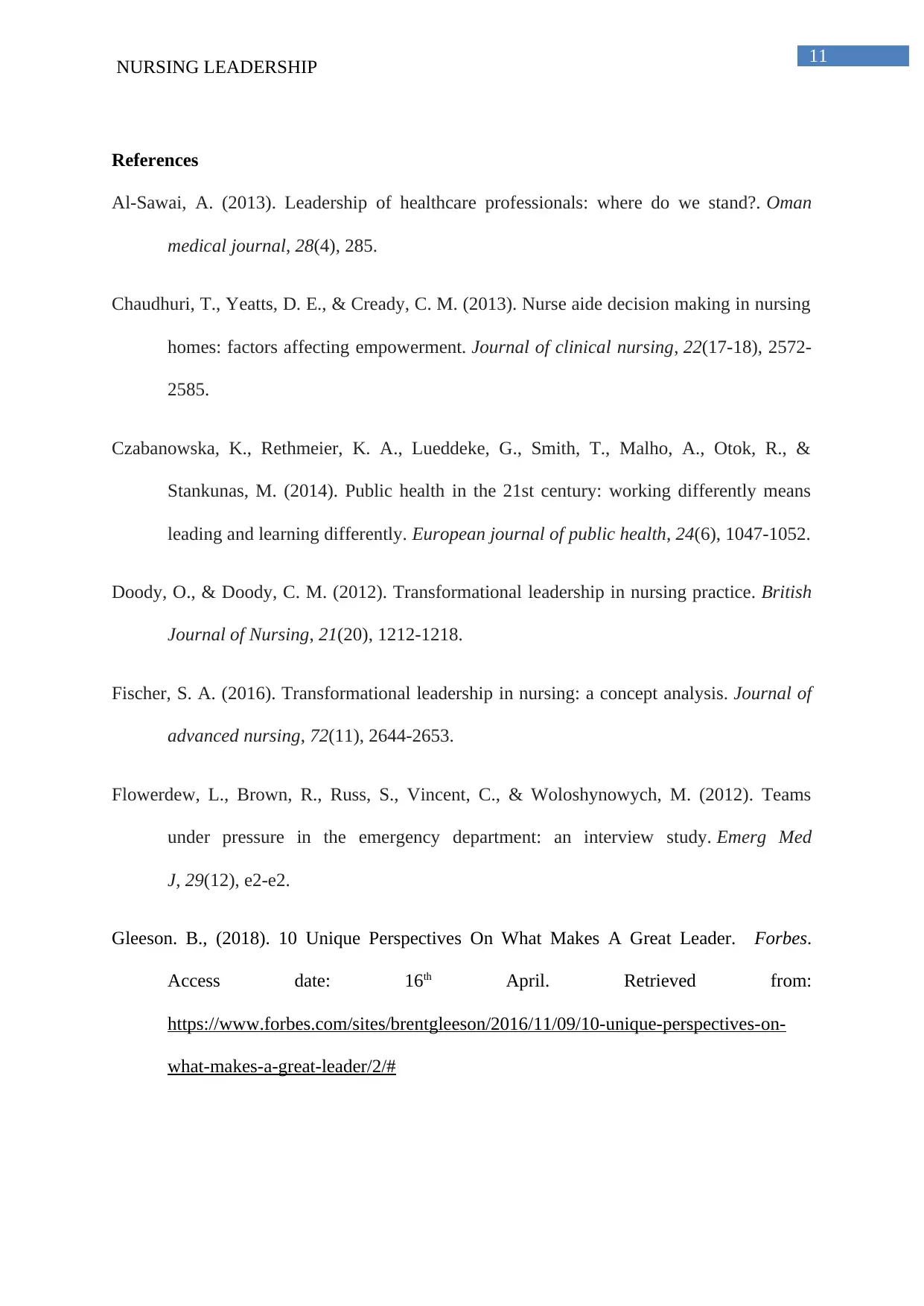
11
NURSING LEADERSHIP
References
Al-Sawai, A. (2013). Leadership of healthcare professionals: where do we stand?. Oman
medical journal, 28(4), 285.
Chaudhuri, T., Yeatts, D. E., & Cready, C. M. (2013). Nurse aide decision making in nursing
homes: factors affecting empowerment. Journal of clinical nursing, 22(17-18), 2572-
2585.
Czabanowska, K., Rethmeier, K. A., Lueddeke, G., Smith, T., Malho, A., Otok, R., &
Stankunas, M. (2014). Public health in the 21st century: working differently means
leading and learning differently. European journal of public health, 24(6), 1047-1052.
Doody, O., & Doody, C. M. (2012). Transformational leadership in nursing practice. British
Journal of Nursing, 21(20), 1212-1218.
Fischer, S. A. (2016). Transformational leadership in nursing: a concept analysis. Journal of
advanced nursing, 72(11), 2644-2653.
Flowerdew, L., Brown, R., Russ, S., Vincent, C., & Woloshynowych, M. (2012). Teams
under pressure in the emergency department: an interview study. Emerg Med
J, 29(12), e2-e2.
Gleeson. B., (2018). 10 Unique Perspectives On What Makes A Great Leader. Forbes.
Access date: 16th April. Retrieved from:
https://www.forbes.com/sites/brentgleeson/2016/11/09/10-unique-perspectives-on-
what-makes-a-great-leader/2/#
NURSING LEADERSHIP
References
Al-Sawai, A. (2013). Leadership of healthcare professionals: where do we stand?. Oman
medical journal, 28(4), 285.
Chaudhuri, T., Yeatts, D. E., & Cready, C. M. (2013). Nurse aide decision making in nursing
homes: factors affecting empowerment. Journal of clinical nursing, 22(17-18), 2572-
2585.
Czabanowska, K., Rethmeier, K. A., Lueddeke, G., Smith, T., Malho, A., Otok, R., &
Stankunas, M. (2014). Public health in the 21st century: working differently means
leading and learning differently. European journal of public health, 24(6), 1047-1052.
Doody, O., & Doody, C. M. (2012). Transformational leadership in nursing practice. British
Journal of Nursing, 21(20), 1212-1218.
Fischer, S. A. (2016). Transformational leadership in nursing: a concept analysis. Journal of
advanced nursing, 72(11), 2644-2653.
Flowerdew, L., Brown, R., Russ, S., Vincent, C., & Woloshynowych, M. (2012). Teams
under pressure in the emergency department: an interview study. Emerg Med
J, 29(12), e2-e2.
Gleeson. B., (2018). 10 Unique Perspectives On What Makes A Great Leader. Forbes.
Access date: 16th April. Retrieved from:
https://www.forbes.com/sites/brentgleeson/2016/11/09/10-unique-perspectives-on-
what-makes-a-great-leader/2/#
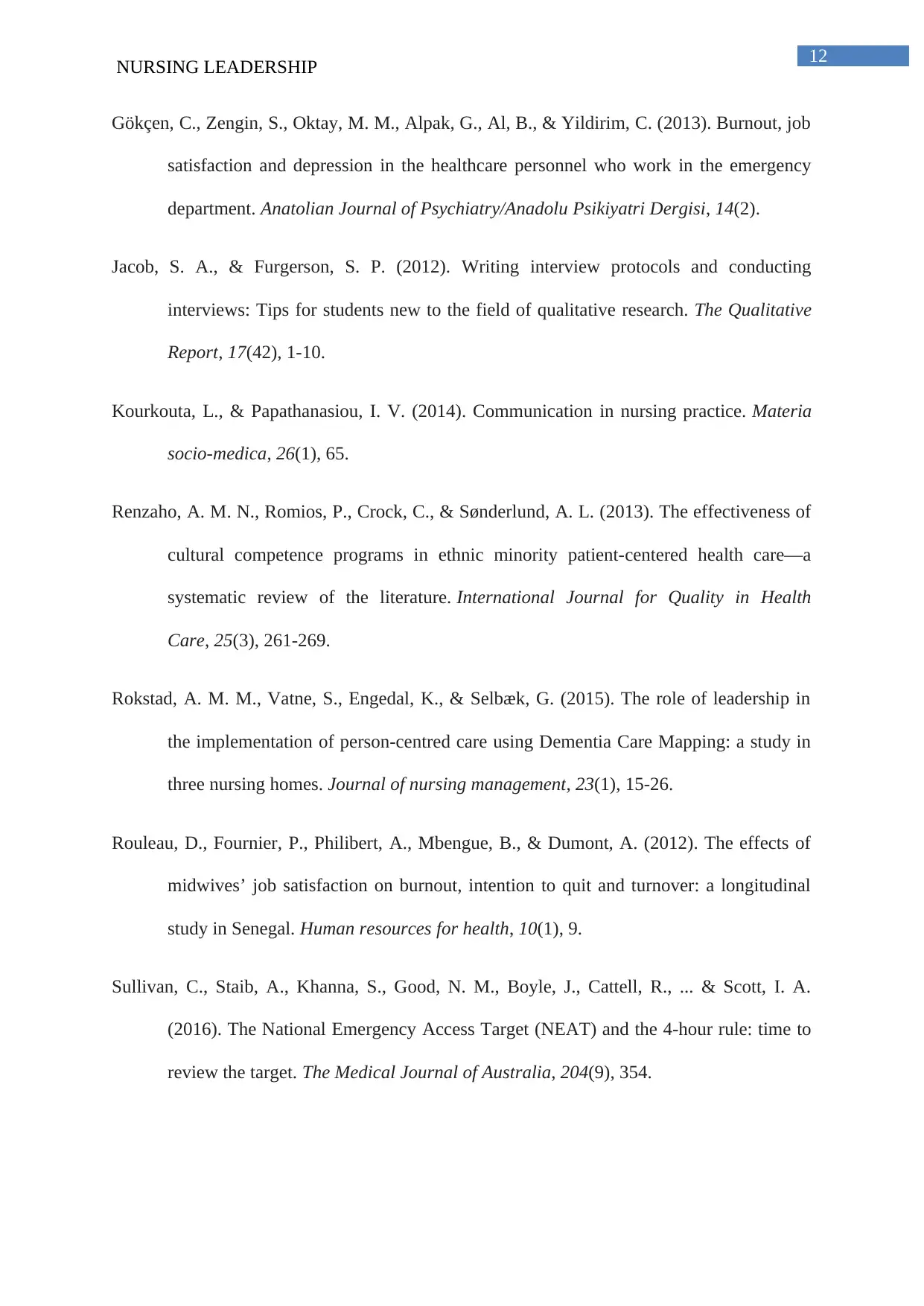
12
NURSING LEADERSHIP
Gökçen, C., Zengin, S., Oktay, M. M., Alpak, G., Al, B., & Yildirim, C. (2013). Burnout, job
satisfaction and depression in the healthcare personnel who work in the emergency
department. Anatolian Journal of Psychiatry/Anadolu Psikiyatri Dergisi, 14(2).
Jacob, S. A., & Furgerson, S. P. (2012). Writing interview protocols and conducting
interviews: Tips for students new to the field of qualitative research. The Qualitative
Report, 17(42), 1-10.
Kourkouta, L., & Papathanasiou, I. V. (2014). Communication in nursing practice. Materia
socio-medica, 26(1), 65.
Renzaho, A. M. N., Romios, P., Crock, C., & Sønderlund, A. L. (2013). The effectiveness of
cultural competence programs in ethnic minority patient-centered health care—a
systematic review of the literature. International Journal for Quality in Health
Care, 25(3), 261-269.
Rokstad, A. M. M., Vatne, S., Engedal, K., & Selbæk, G. (2015). The role of leadership in
the implementation of person‐centred care using Dementia Care Mapping: a study in
three nursing homes. Journal of nursing management, 23(1), 15-26.
Rouleau, D., Fournier, P., Philibert, A., Mbengue, B., & Dumont, A. (2012). The effects of
midwives’ job satisfaction on burnout, intention to quit and turnover: a longitudinal
study in Senegal. Human resources for health, 10(1), 9.
Sullivan, C., Staib, A., Khanna, S., Good, N. M., Boyle, J., Cattell, R., ... & Scott, I. A.
(2016). The National Emergency Access Target (NEAT) and the 4-hour rule: time to
review the target. The Medical Journal of Australia, 204(9), 354.
NURSING LEADERSHIP
Gökçen, C., Zengin, S., Oktay, M. M., Alpak, G., Al, B., & Yildirim, C. (2013). Burnout, job
satisfaction and depression in the healthcare personnel who work in the emergency
department. Anatolian Journal of Psychiatry/Anadolu Psikiyatri Dergisi, 14(2).
Jacob, S. A., & Furgerson, S. P. (2012). Writing interview protocols and conducting
interviews: Tips for students new to the field of qualitative research. The Qualitative
Report, 17(42), 1-10.
Kourkouta, L., & Papathanasiou, I. V. (2014). Communication in nursing practice. Materia
socio-medica, 26(1), 65.
Renzaho, A. M. N., Romios, P., Crock, C., & Sønderlund, A. L. (2013). The effectiveness of
cultural competence programs in ethnic minority patient-centered health care—a
systematic review of the literature. International Journal for Quality in Health
Care, 25(3), 261-269.
Rokstad, A. M. M., Vatne, S., Engedal, K., & Selbæk, G. (2015). The role of leadership in
the implementation of person‐centred care using Dementia Care Mapping: a study in
three nursing homes. Journal of nursing management, 23(1), 15-26.
Rouleau, D., Fournier, P., Philibert, A., Mbengue, B., & Dumont, A. (2012). The effects of
midwives’ job satisfaction on burnout, intention to quit and turnover: a longitudinal
study in Senegal. Human resources for health, 10(1), 9.
Sullivan, C., Staib, A., Khanna, S., Good, N. M., Boyle, J., Cattell, R., ... & Scott, I. A.
(2016). The National Emergency Access Target (NEAT) and the 4-hour rule: time to
review the target. The Medical Journal of Australia, 204(9), 354.
Paraphrase This Document
Need a fresh take? Get an instant paraphrase of this document with our AI Paraphraser
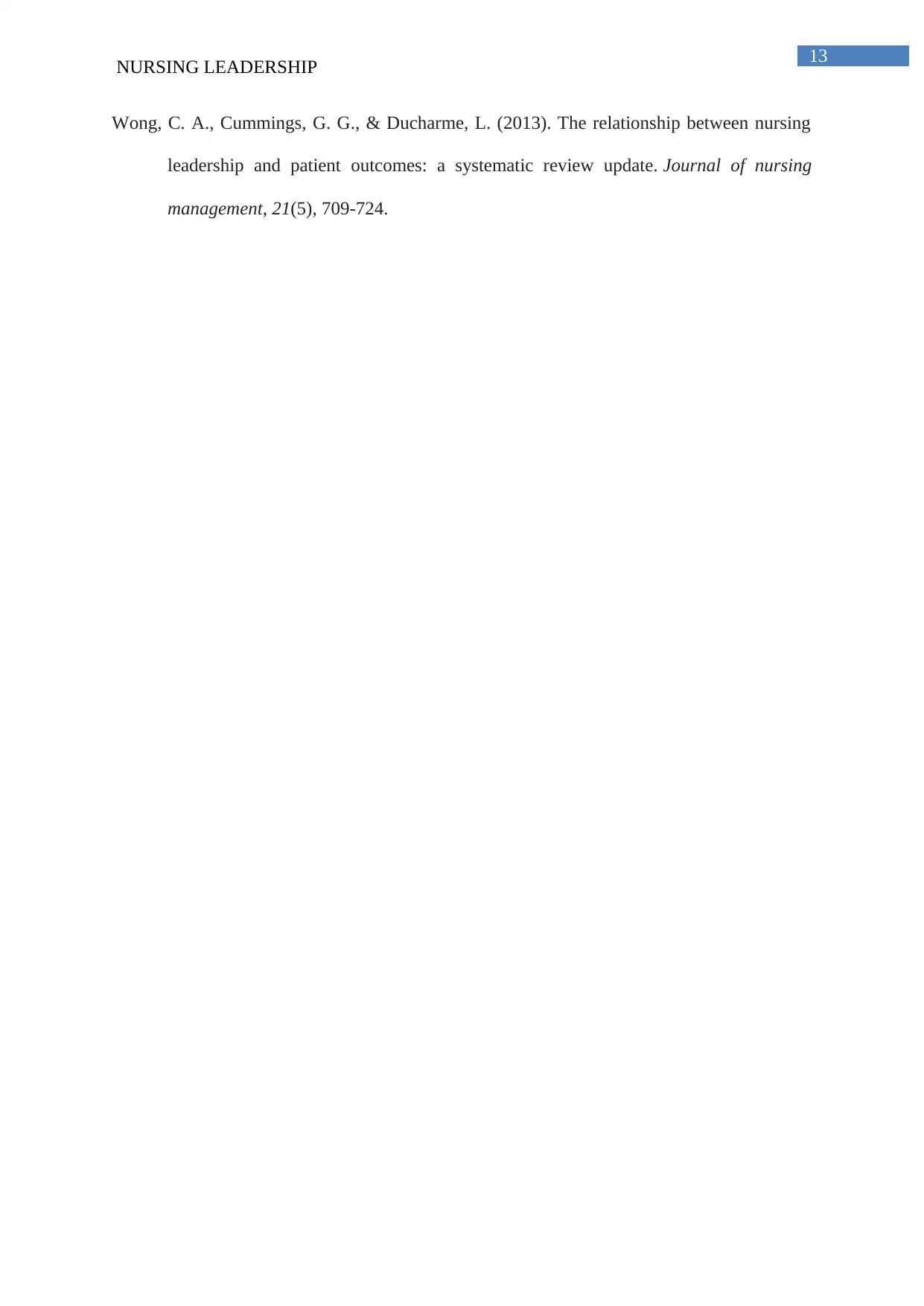
13
NURSING LEADERSHIP
Wong, C. A., Cummings, G. G., & Ducharme, L. (2013). The relationship between nursing
leadership and patient outcomes: a systematic review update. Journal of nursing
management, 21(5), 709-724.
NURSING LEADERSHIP
Wong, C. A., Cummings, G. G., & Ducharme, L. (2013). The relationship between nursing
leadership and patient outcomes: a systematic review update. Journal of nursing
management, 21(5), 709-724.
1 out of 14
Related Documents
Your All-in-One AI-Powered Toolkit for Academic Success.
+13062052269
info@desklib.com
Available 24*7 on WhatsApp / Email
![[object Object]](/_next/static/media/star-bottom.7253800d.svg)
Unlock your academic potential
© 2024 | Zucol Services PVT LTD | All rights reserved.





